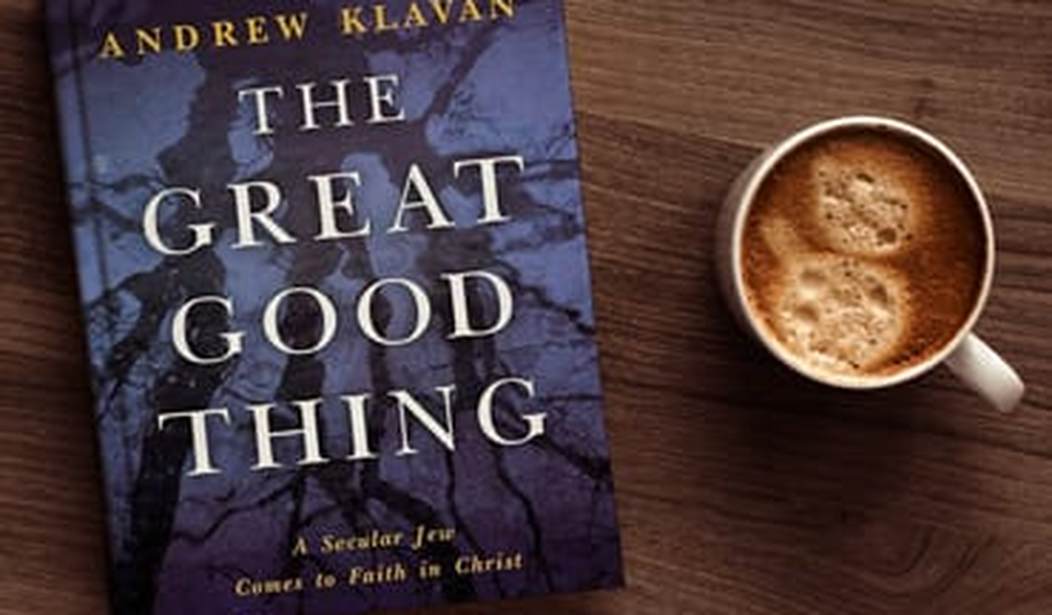Who is a Jew? What is a Christian? Can one be both at the same time? And who, precisely, gets to decide? These and other thorny questions are addressed by (full disclosure) my friend, PJ Media colleague, and fellow author and screenwriter Andrew Klavan in a new book that is at once challenging, depressing, and, in the end, profoundly joyous. In short, something for everyone and something to offend everyone, as a great good book should be.
The Great Good Thing: A Secular Jew Comes to Faith in Christ chronicles the best-selling author’s life from his boyhood as an irreligious Jew from the leafy Long Island suburb of Great Neck, through his struggles as a young writer, husband and father, his relocation to California for personal and professional reasons to… the moment of his baptism at the Episcopal Church of the Incarnation in midtown Manhattan at the age of 49.
No one could have been more surprised than I was. I never thought I was the type. I had been born and raised a Jew and lived most of my life as an agnostic. I believed in the fullest freedom of thought into the widest reaches of fact and philosophy. I believed in science and analysis and reasonable explanations. I had no time for magical thinking of any kind. I couldn’t bear solemn piety.
And yet…
Few are the writers who do not struggle with the themes of faith and belief. Not necessarily overtly, of course; that would be what we call in Hollywood “on the nose” — that is, without subtext. But from Dostoevsky to Bulgakov, to Dickens and Wilkie Collins, to Faulkner and Steinbeck and Ken Kesey, it’s always there, bubbling under the surface. What do we believe? Is there a Higher Power? And how can we, rationally, believe in it? Embrace it or reject it, but Christianity is the foundation from which nearly every great work of western art springs. To be an artist is to be forced to confront it.
(This, by the way, is another reason to despise Islam, which would destroy it — music, art, architecture, the lot — and the militant atheists who enable them. But I digress.)
So it’s no accident that Klavan came to Christianity via the culture. For a civilized, educated human being of any faith, the world is incomprehensible without understanding the semiotics of Christianity, its signs, symbols, legends, lores and portents. Indeed, you can hardly look at a single Medieval or Renaissance painting without understanding the Biblical basis of what’s being depicted. Why does St. Jerome hold a skull, accompanied by a lion? Why is St. Catherine always shown with a wheel? How can you possibly understand what the artist is trying to communicate, without having to spell it out, if you don’t know the back story?
But Drew’s conversion actually begins even earlier, historically, when he confronts one of the central events in Christianity — Pilate’s interrogation of Jesus:
The oldest fragment of New Testament papyrus we have preserves the question of the sophisticated Roman official Pontius Pilate as he sits in judgment over the backwoods Jewish preacher Jesus of Nazareth: “What is truth?” The Gospel’s weird answer has already been spoken by Jesus elsewhere in the narrative. “I am the way and the truth and the life,” he says.
That’s a question every writer asks himself every time he sits down at the keyboard: what is Truth? (Jesus offers no help. In the Gospel of St. John 18:38, his response, if any, is not recorded.) How do I discover it, get at it, recognize it? How do my characters react — do they deny it, avoid it, fight it, live with it? It’s the central question of our existence here on earth, so naturally it’s the central question of every work of literature. Klavan writes with a novelist’s scalpel and turns the blade of observation upon himself. Sometimes it’s not a pretty sight, but that’s the brutally honest nature of the medium.
The autobiographical material at the start of the book — his childhood in Great Neck, his familial estrangement from Jewish culture, his first Christmas in a Christian home, his loathing of formal schooling, and, most tellingly, his heartbreaking rejection of his bar mitzvah gifts — is riveting.
Now, when I opened the leather box, when I looked down at the gold and silver and gems and US Bonds, it was a bitter, bitter thing. Even the pleasant chill of metal seemed to have faded from the stuff. It felt warm and clammy under my fingertips. I took the box out of its cabient less and less often and finally not at all; I just left it in there.
And then, one midnight, when the family was asleep, he took the box outside and stuffed it into the garbage.
Everyone’s life is unique, of course, but not everyone has the literary skill and the emotional honesty to dissect it in cold blood. Of his mother, he writes:
She was an anti-Semite. It’s true. She was just as Jewish as the rest of us, mind — only not. Not in her own imagination anyway. For one thing, she had some Austrian blood, I’m not sure how much, but enough, I guess, to give her bragging rights over Ashkenazi or Eastern European Jews who are traditionally regarded as lower class by upper-class Germans and Austrians.
But this is neither a family memoir nor the author’s revenge on his parents and teachers. By his own account, life in Great Neck was idyllic, a perfect place for a boy whose life was largely spent lost in dreams and stories. As a kindred writer knows, that life is not quite as appealing as it sounds; unchecked it leads to a kind of fine madness that makes it difficult to relate to others, whether parents, siblings or friends. We get lost in our stories and our characters; we become God’s mad men, imitating Him in the act of very imperfect creation. The body count can be horrendous.
Klavan’s account of the writers who influenced him, among them Raymond Chandler, will resonate with other professional writers, for we learn not from college courses or the Meat Loaf Writers Conference (okay, Bread Loaf), but from reading other writers. From Chandler, I believe, Klavan adapted his lean, observational style as well as –and this is crucial — the discipline to sit down every single day and write. (My own advice to young writers is 1) ass in chair, 2) fingers on keyboard, 3) start typing. Elves just don’t cut it.)
As a reader, one awaits the Big Reveal, the moment when Christ comes down from the Cross, but for Klavan it was more like a series of small, personal revelations; his is not a sudden conversion on a whim, but the result of what he calls Five Epiphanies, one of which is a harrowing journey into what the great American novelist, William Styron, called Darkness Visible: depression and thoughts of suicide. Therapy. The birth of a child. And, above all, Love.
The authorial template for all such books is C.S. Lewis, who limned his own journey from enforced faith, to atheism, to a return to the Church of Ireland (the Irish version of the Church of England) in such works as Mere Christianity and Surprised by Joy; with Lewis, Klavan might well say:
I believe in Christianity as I believe that the Sun has risen, not only because I see it but because by it I see everything else.
And this is the central issue of faith: how does one believe when the evidence of one’s senses argues against it? But that is the essence of faith itself: the more you don’t believe a word of this arrant, superstitious rubbish, the more you must believe. And thus the more you actually do believe. Unbelief, or perhaps disbelief, I would argue — and as Klavan’s remarkable book demonstrates — is the very precondition and essence of true belief.
The fifth epiphany. The fifth fragment.
The truth of suffering. The wisdom of joy. The reality of love, The possibility of clear perception. The laughter at the heart of mourning.
I had them all now, all the pieces I needed The five revelations that were really one revelation: the presence of God.
Some might call The Great Good Thing brave, and wonder why he wrote it. I call it honest, and know he had to write it.
Believe it, or don’t. The choice is yours. The choice is all of ours.











Join the conversation as a VIP Member